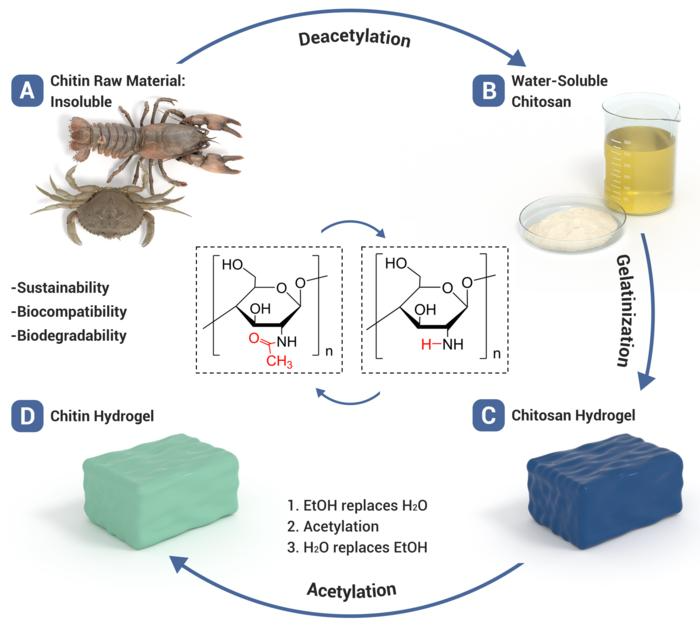For several biomedical applications, chitin hydrogel is known to be a promising material. It is beneficial for tissue repair, artificial organs, and wound healing due to its biocompatibility and biodegradability. However, producing chitin hydrogel remains a difficult task for scientists. A group of researchers has created a scalable, eco-friendly, and effective method for making chitin hydrogels.

This schematic shows the preparation of chitin hydrogel via the solvent exchange-assisted acetylation of chitosan hydrogel. Image Credit: Nano Research, Tsinghua University Press
The team’s research offers a logical method for creating chitin hydrogels and paves the road for their practical use as an excellent biomedical material.
Their study was published on July 1st, 2023, in the journal Nano Research.
The exoskeletons of insects, prawns, and crabs contain chitin, the second most prevalent natural polymer. Chitin is inexpensive, biocompatible, renewable, and degradable. Due to these characteristics, it is a top choice for numerous biomedical applications.
Chitin hydrogel, which shares many similarities with extracellular matrix, is an ideal material for tissue engineering and regenerative medicine. However, it is a challenge to dissolve chitin in aqueous solutions to produce hydrogel materials. Therefore, it is of great significance to develop rational fabrication strategy.
Li-Bo Mao, Professor, University of Science and Technology
The chitin hydrogel must be biologically safe, have the required mechanical strength, and be chemically stable to be effective in biomedical applications. It must be able to fend off biofouling, which could trigger an immunological reaction or an inflammatory response in the human body. The chitin hydrogel must also be affordable and scalable for commercial use.
Since chitin is insoluble in many solvents and has a shorter chain length when formed from solutions, it presents difficulties in fabricating robust chitin hydrogel. The dissolution of the biopolymer and subsequent gelation are the two steps that are generally used to create biopolymer hydrogels.
However, due to the strong intra- and intermolecular hydrogen bonds that exist between the polymer chains, chitin is not soluble in water or other common solvents. The group met this problem by chemically converting chitosan, a water-soluble deacetylated derivative of chitin, into chitin hydrogel with a biomimetic structure.
Chitosan dissolves readily in water when acids are present. Different microstructures can be added to these chitosan hydrogels. They are not, however, chemically or mechanically stable. Concerns about biosafety have been highlighted in attempts to use crosslinking agents to improve them.
The team was successful in creating an acetylation-based chitin hydrogel that is chemically stable and antifouling. The chitin hydrogel that the researchers created through the acetylation procedure exhibits exceptional resilience to swelling, degradation, high temperature and pH conditions, and organic solvents.
The researchers also discovered that by templating the chitosan precursor with ice crystals, they were able to create chitin hydrogels with various biomimetic shapes. Depending on the freezing process utilized with the chitosan precursor, these structures can be nacre-like or wood-like.
The team’s chitin hydrogel exhibits superior mechanical characteristics while retaining a high water content. Additionally, it exhibits outstanding antifouling performance by thwarting the adherence of blood, cells, proteins, and bacteria.
Mao added, “Besides the many advantages that are characteristic to chitin, the hydrogel materials we obtained are mechanically strong and robust. In addition, the hydrogels can be feasibly processed into different shapes and structures. These ensure the practical applications of the chitin hydrogels.”
The team’s next task will be to enhance the chitin hydrogels’ mechanical properties and investigate their potential uses in biomedicine using in vivo tests.
Mao further stated, “We anticipate various chitin-based hydrogel materials can be fabricated through this strategy and used for different clinical applications, such as cartilage replacement, bone replacement, wound dressing, and even artificial organs.”
The research team consists of Rui-Rui Liu, Yu-Feng Meng, Li-Bo Mao, and Shu-Hong Yu from the University of Science and Technology of China; and Qian-Qian Shi and Yong Zhou from the Anhui Province Medical University.
The National Natural Science Foundation of China, the Key Scientific Research Foundation of the Education Department of Anhui Province, and the National Key Research and Development Program of China provided funding for the study.
Journal Reference
Liu, R.-R., et al. (2023) Biomimetic chitin hydrogel via chemical transformation. Nano Research. doi:10.1007/s12274-023-5886-5.
Source: http://www.tup.tsinghua.edu.cn/en/index.html